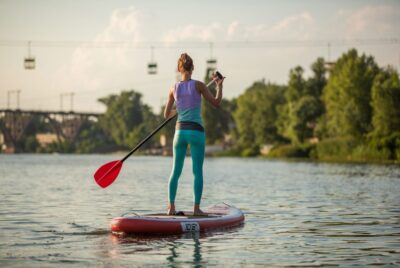Are Inflatable Paddle Boards Good? The Answer May Surprise You…
*We may earn a commission for purchases made using our links. Please see our disclosure to learn more.
Deciding on the right paddle board can be tricky. Many say inflatable paddle boards are game-changers, offering a blend of convenience and adventure. This post will dive into their benefits and drawbacks, helping you choose with confidence.
Let’s get paddling!
| Looking for our best paddle board product recommendations? Check the Paddleboard Insiders Buyer Guides |
Table Of Contents
Pros of Inflatable Paddle Boards
Inflatable paddle boards are highly portable and easy to store, making them perfect for travel and small living spaces. Their durable construction allows for use in a variety of water conditions, and they offer stability on the water that is great for beginners.
Plus, inflatable paddle boards come at a lower price point compared to rigid epoxy boards, making them more accessible to a wider range of people.
Portability and storage
One of the biggest benefits of inflatable paddle boards is their ease of transport. Unlike rigid boards, you can deflate them, roll them up, and fit them into a carry bag. This means you can easily take your paddle board with you on road trips, flights or hikes to remote lakes without needing a roof rack or large vehicle.
Storing an inflatable paddle board when it’s not in use also requires less space than storing a hardboard. You can keep it in your closet, garage corner or even under your bed if space is tight! This makes inflatable SUPs ideal for those living in apartments or homes with limited storage options.
They are ready for adventure whenever you are – just inflate and hit the water!
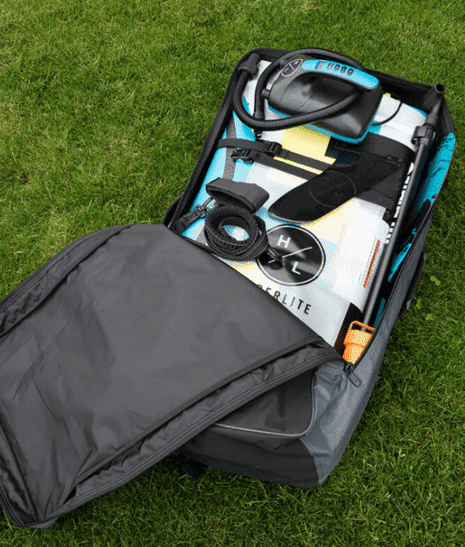
Durability
Inflatable paddle boards stand out for their resilience against wear and tear. Made with multiple layers of material, they can take quite a beating from pebbly beaches, sticks, and other sharp objects without getting damaged.
Unlike traditional hard boards that might crack or ding if dropped or hit something underwater, inflatables tend to bounce back from impacts. Their sturdy construction means they often last longer than you’d expect, helping paddlers avoid frequent replacements.
Caring for an inflatable board also tends to be easier since small punctures or abrasions can typically be patched up quickly with a repair kit. This toughness makes them a solid choice for adventurers who want to explore different environments without worrying about damaging their gear.
With durability being such a strong point for these boards, it’s clear why many people choose them for their water sports activities.
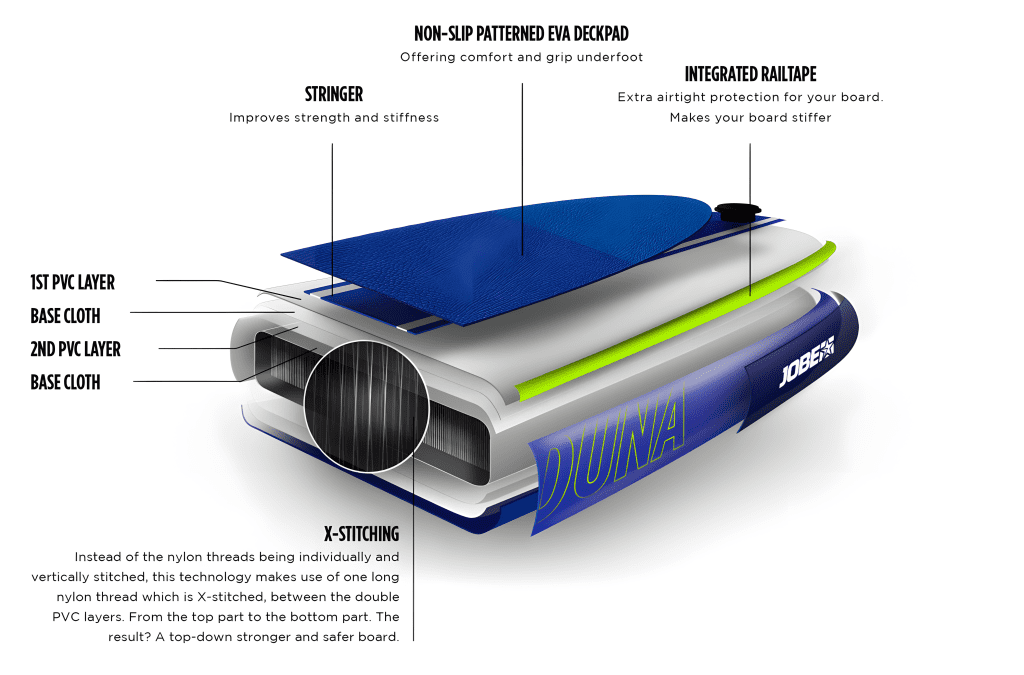
Stability
Paddle board stability matters, especially for beginners who are just getting their feet wet. Inflatable paddle boards offer a solid balance between firmness and buoyancy, which can make all the difference on calm water.
Unlike hard boards that can feel twitchy to newbies, these inflatable versions use air pressure to create a sturdy platform that lessens wobbles and dips.
They handle well in both flatwater paddling and some choppier conditions. Built with multiple layers of material, they provide a steady ride by absorbing the shifts and movements on the surface of the water.
This added stability doesn’t just boost confidence; it’s also a safety feature, helping reduce unexpected tumbles into the water.
Price point compared to epoxy boards
Inflatable paddle boards generally come at a more affordable price point compared to epoxy boards, making them an attractive option for those looking for a budget-friendly alternative.
This lower cost allows more people to access the sport of paddle boarding without breaking the bank. Additionally, while epoxy boards can require additional expenses such as transport and storage solutions, inflatable paddle boards offer greater convenience due to their portability and ease of storage, ultimately saving users money in the long run.
When considering the price point, it’s crucial to weigh the durability and performance benefits against the upfront investment. Inflatable paddle boards often provide a cost-effective entry into the sport while maintaining quality construction and competitive features that make them an appealing choice for both beginners and experienced paddlers alike.
Ease of repair
Inflatable paddle boards are relatively easy to repair compared to traditional solid boards. The materials used in inflatable boards, such as PVC and drop-stitch construction, make them resilient and repairable.
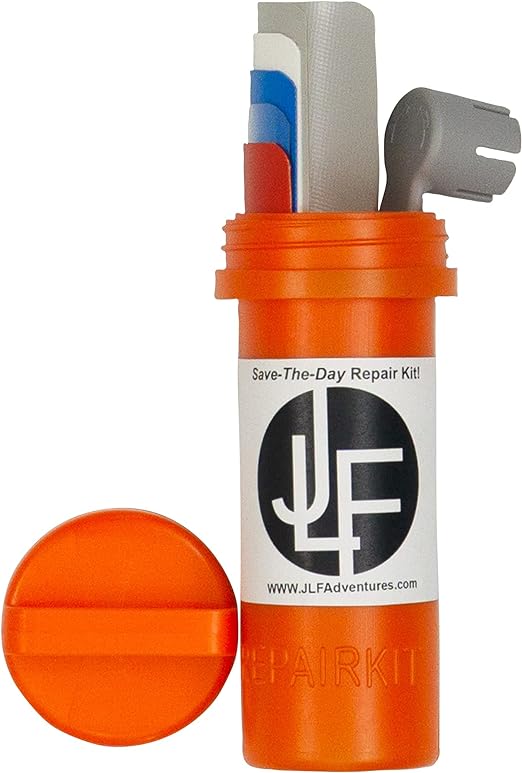
Small punctures or tears can often be fixed using a patch kit, which is usually included with the board. This makes maintenance simple and cost-effective, ensuring that minor damages don’t result in expensive repairs or replacements.
The repair process for inflatable paddle boards generally involves cleaning the affected area, applying adhesive, and affixing the patch. Once repaired, the board can continue to provide reliable performance on the water.
Cons of Inflatable Paddle Boards
Performance may not match rigid boards, setup time can be longer, and prep time for storage could also take longer compared to traditional hard boards.
Performance may not match rigid boards
Inflatable paddle boards may not perform as well in rough water paddling compared to traditional solid boards. The flexibility of inflatable boards can impact their responsiveness and speed, potentially limiting their performance when navigating challenging water conditions.
It’s important to consider the specific water activities you plan to engage in before choosing between inflatable and rigid paddle boards.
While inflatable paddle boards offer several benefits such as portability, storage, and durability, their performance may fall short when it comes to handling rough waters. Understanding this aspect is crucial for individuals seeking a board that meets their specific needs and preferences.
Longer set-up time
Inflatable paddle boards necessitate a longer set-up time than their rigid counterparts, requiring inflation and attachment of fins before hitting the water. This additional prep time can be a minor inconvenience for users seeking quick and spontaneous paddling adventures.
However, the trade-off is the board’s portability and ease of storage, making it suitable for those willing to invest some extra minutes in setup for improved convenience during transportation.
While some may find the longer set-up time off-putting, it’s important to weigh this factor against the benefits of durability, stability, and affordability that inflatable paddle boards offer.
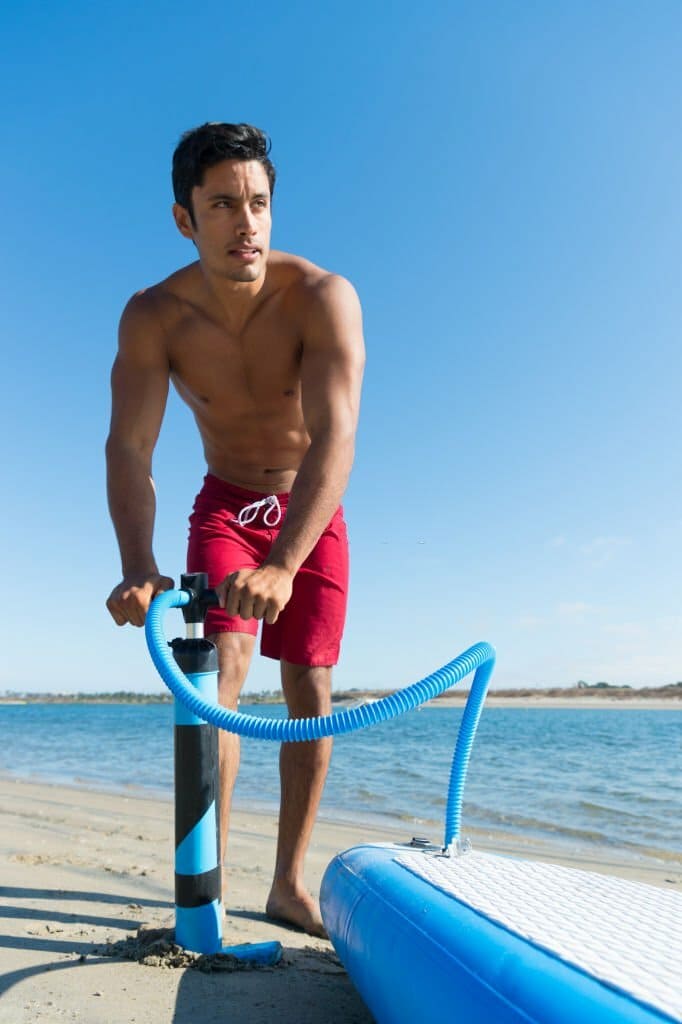
| This can be negated using an electric pump, you can find out more here: The 9 Best Electric Paddleboard Air Pumps Of 2024 |
Longer prep time for storage
Inflatable paddle boards require more time for storage preparation due to the need to deflate, roll, and properly pack them away. To ensure longevity, it’s essential to thoroughly dry the board before storing it.
Additionally, proper folding techniques are crucial to prevent damage during extended periods of storage. However, despite the longer prep time for storage, inflatable paddle boards offer a convenient and space-saving option compared to traditional hard boards.
When considering the longer prep time for storage aspect of inflatable paddle boards, it’s important to acknowledge that this additional step is necessary in maintaining their durability and performance over time.
| Here’s what you need to know about storing and transporting a SUP: The Best Paddleboard Rack To Store & Transport Your SUPs |
Best Inflatable Paddle Boards of 2024
Here are my 3 favorite inflatable paddle boards on the market right now.
| NOTE: This is a brief summary of 3 great inflatable paddle boards – For a detailed review go here: The 8 Best Inflatable Paddle Boards Of 2024 Reviewed |
Recommendation 1: Tower Adventurer 2
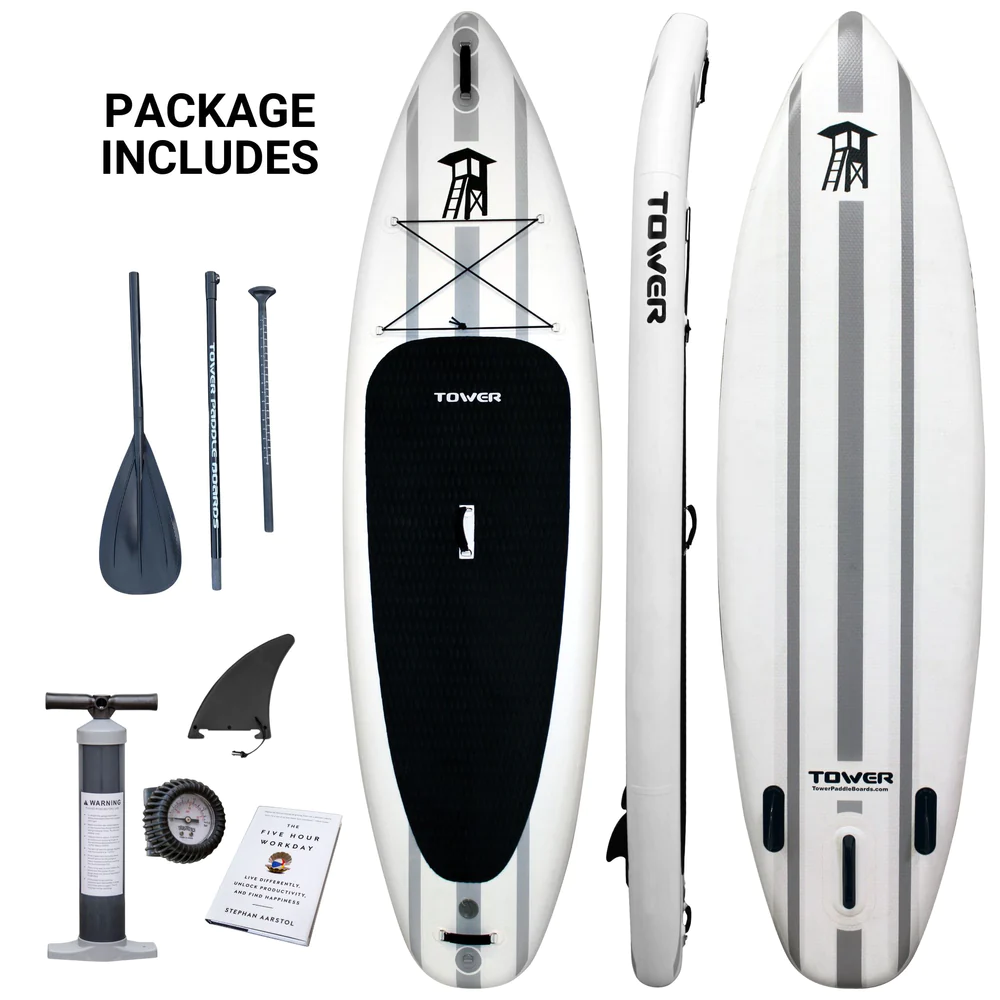
Where To Buy: Tower Paddleboards
Specs & Features:
– Dimensions of 10’4″ x 32″ x 6′
– Weight capacity of 350 lbs
– Comes with paddle, board, pump, fin and book
The Tower Adventurer 2 inflatable paddle board stands out as an exceptional choice for paddlers of all skill levels, particularly beginners. It’s well-regarded for its excellent stability and support, making it a fantastic tool for newcomers to build their confidence on the water. Coming from the Tower brand, which holds a strong reputation for quality in the paddle board market, this board is synonymous with reliability. It offers an easy-to-stand-on surface and exceptional durability, making it an ideal option for most enthusiasts.
This paddle board excels in recreational use, skilfully balancing stability with maneuverability. Whether it’s a family outing or a beginner’s first time on a paddle board, the Tower Adventurer 2 is an outstanding choice for anyone looking for a reliable and enjoyable paddleboarding experience.
| Check Price ➡️ Tower Paddleboards |
Recommendation 2: ISLE Pioneer 10’6″
Where To Buy: Amazon
Key Features:
– Dimensions of 10’6″
– Weight capacity of 285lb
– Comes with bag, leash, fin and paddle
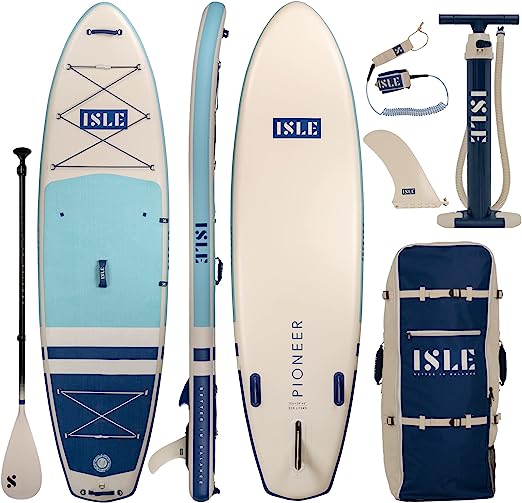
The ISLE Pioneer paddleboard, renowned as the original bestseller from ISLE, is crafted to be the quintessential all-around board. Its standout feature is a sturdy double-layer construction, enhanced by cutting-edge drop-stitch technology, providing unmatched durability.
This inflatable paddleboard is a blend of stability and a lightweight build, making it perfect for riders up to 285 lbs. Especially suitable for beginners, this board is definitely worth considering for your next ISLE paddleboarding adventure.
| Check Price ➡️ Amazon |
Recommendation 3: Atoll 11′ iSUP
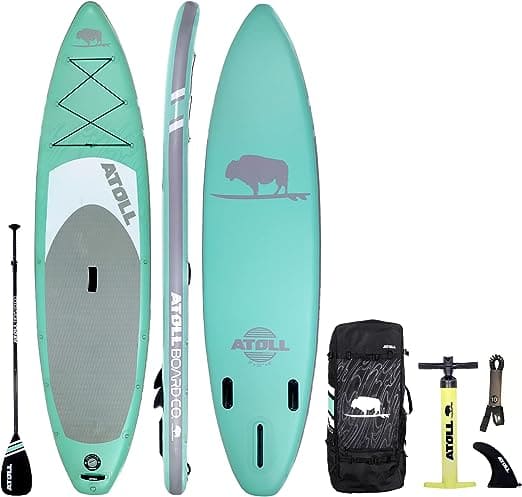
Where To Buy: Amazon
Specs & Features:
– Dimensions of 11′ x 32″ x 25″
– Weight capacity of 400 lbs
– Comes with board, bag, leash, fin and paddle
The 2024 Atoll Inflatable Stand Up Paddle Board (ISUP) is a superb choice for heavier paddlers, featuring a lightweight, dual-layer PVC construction that’s 40% lighter than similar models. This 11-foot board includes an easy-to-use high-pressure Bravo dual-action hand pump. The package also contains a lightweight black aluminum alloy paddle and a tool-free detachable fin that fits most fin boxes.
The board, measuring 25 inches thick, 32 inches wide, and 11 feet long, is designed for versatility and durability. It has a double PVC layer for extra strength, 15 D-rings for multiple uses, and a Tri-fin design for improved stability. A heavy-duty backpack with mesh sides is included for convenient transport and drying, and a 2-year manufacturer’s warranty offers additional peace of mind. It’s a great choice for those starting in paddleboarding or looking to upgrade their equipment.
| Check Price ➡️ Amazon |
Choosing the Right Inflatable Paddle Board
Consider factors such as size, shape, price, construction, and features when selecting the best inflatable paddle board for your needs.
Factors to consider such as size, shape, price, construction, and features
Consider the following factors when choosing an inflatable paddle board:

- Size: The length and width of the board determine its stability, speed, and weight capacity. Consider your body weight and intended use.
- Shape: Determine if you need a rounded nose for better maneuverability or a pointed nose for increased speed and efficiency through the water.
- Price: Decide on a budget that aligns with your desired features while considering long-term durability and performance.
- Construction: Assess the quality of the materials used in the construction of the board, taking into consideration durability, strength, and resistance to punctures.
- Features: Evaluate additional components such as traction pads, bungee cords, D-rings, fins, and carry handles to complement your paddling experience.
Is an Inflatable Paddle Board Worth It?
Inflatable SUPs offer excellent value with a wide range of price options to suit different budgets. High-quality inflatable paddle boards can be found at competitive prices, making them an accessible choice for water enthusiasts.
Durability, portability, and stable performance make these boards an attractive investment, even for those new to the sport. Many inflatable SUP models come with safety features and durable materials that make them suitable for various water activities.
Exploring the value of inflatable SUPs and different price ranges. Want to know if it’s worth it? Keep reading to find out!
Exploring the value of inflatable SUPs and different price ranges
As the popularity of paddle boarding grows, manufacturers continue to innovate in design and construction while keeping prices competitive. With careful consideration of individual needs and preferences, choosing the right inflatable SUP from different price ranges can provide a satisfying experience on the water without breaking the bank.

Conclusion
Considering the pros and cons highlighted, it’s clear that inflatable paddle boards offer portability and durability. They are also stable and come at a more affordable price compared to solid boards.
However, their performance in rough waters may not match rigid boards, and they require longer set-up and prep time for storage. When choosing an inflatable paddle board, carefully weighing these factors is essential to making an informed decision about whether they are a good fit for your needs.
| Looking for insider guides to some amazing paddle boarding locations? Check the Paddleboard Insiders Location Guides |
FAQ’s
Are inflatable paddle boards hard to use?
Inflatable paddle boards (SUPs) are generally not hard to use. They are often recommended for beginners due to their stability and ease of maneuvering. The main challenge might be inflating them, which requires some effort but can be simplified with an electric pump.
| Here is a great article on this topic: Is Paddleboarding Hard? Not If You Follow This… |
Do inflatable SUPs last?
Yes, inflatable SUPs can last a long time if properly cared for. They are made of durable materials like PVC and often have multiple layers for added strength. However, their longevity depends on factors such as frequency of use, exposure to elements, and how well they are maintained..
Do inflatable paddle boards pop easily?
Inflatable paddle boards are designed to be tough and are not prone to popping under normal usage conditions. They can withstand bumps and impacts quite well. However, they can be damaged by sharp objects or extremely rough handling.
Is it OK to keep an inflatable paddle board inflated?
It is generally okay to keep an inflatable paddle board inflated, especially if you use it frequently. However, it’s important to store it out of direct sunlight and to check the air pressure regularly. Long-term storage while fully inflated can put unnecessary stress on the seams and material.
Should I get an inflatable paddle board or solid?
The choice depends on your needs. Inflatable SUPs are great for easy transport and storage, making them ideal for casual use. Solid boards, however, offer better performance and durability for serious or competitive paddling. Consider how and where you’ll use the board to make the best decision.
| Here is a more detailed analysis of this topic: Fiberglass Paddleboard vs. Inflatable Paddleboard: Which Should You Buy? |



